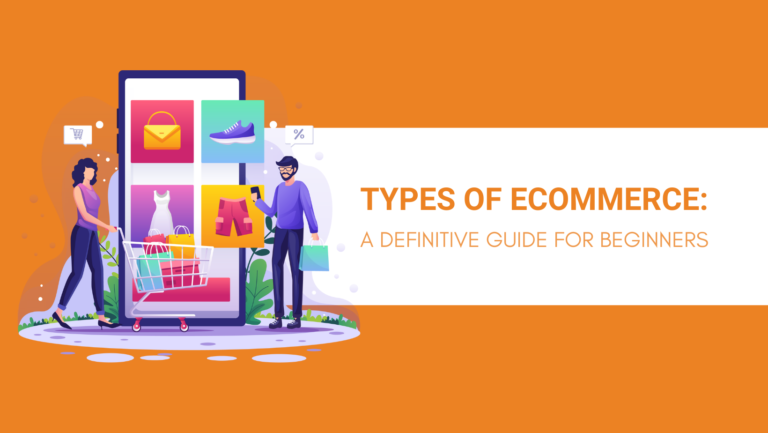E-commerce has transformed how people shop, making it easier than ever to start an online business.
Whether you want to sell physical products, digital goods, or services, there’s an ecommerce business model that fits your goals.
But before diving in, it’s important to understand the different types of e-commerce models and how they work. Choosing the right one can make all the difference in your success.
In this guide, we’ll break down the most common e-commerce business models, their pros and cons, and how to decide which is right for you. Let’s get started!

8 Different Types of Ecommerce Business Models
When we talk about eCommerce, most would think of an online marketplace or a site that connects buyers and sellers.
While the general idea is correct, the word eCommerce itself is just an umbrella term covering many different business models.
So let’s go over some of the most common types of eCommerce business models.
1) Business-to-Business (B2B)
B2B is a business model in which one business sells its services or products to another business. Sometimes, the buyer might be the end-user but in most cases, they’re conventional retailers and wholesalers.
B2B companies usually have a high minimum order quantity (MOQ) but charge a lower per-unit price in comparison to other retailers. Starting a B2B business also typically requires a high initial investment.
B2B Examples
- Platforms like Alibaba where the majority of the merchants only sell products in bulk and the buyers are also usually resellers
- An online security firm selling its security software to an eCommerce site to keep customer data and credit card information safe
2) Business-to-Consumer (B2C)

B2C is what most people think of when they imagine an eCommerce business.
It’s the traditional concept of online buying and selling between a business and an end-user.
B2C is one of the most common eCommerce business models.
Basically, anything you purchase from an online store as an end-user will be considered a B2C transaction.
B2C companies don’t usually have a minimum order quantity, but their prices are slightly higher than B2B companies.
B2C Examples
- Marketplaces like AliExpress and Walmart where most of the buyers are also the end-users
- Online banking services like Payoneer and PayPal
3) Business-to-Business-to-Consumer (B2B2C)
You now know the meaning of B2B as well as B2C – so what in the world is B2B2C? Well, it’s simply a mix of both of these business models.
A B2B2C business interacts with customers using a third-party platform, rather than directly through their own brand.
Let’s just say that there are three parties involved in a B2B2C business model. There’s a primary brand, a middleman, and then the customer.
The customer knows they’re buying from the primary brand, but they’re connecting with them through a middleman, which in this case, is usually a platform.
B2B2C Examples
- Selling on platforms like AliExpress, Amazon, or Etsy.
- Google Playstore and Apple App Store.
4) Direct-to-Consumer (D2C/DTC)

D2C or DTC is a type of eCommerce business in which manufacturers directly sell their products to customers.
This sales strategy doesn’t rely on retailers or distribution networks to help generate sales.
The D2C model has become increasingly popular, especially with brands that leverage social media and influencer marketing to reach their audience. However, it requires significant investment in marketing, customer acquisition, and logistics—making it a challenging model for beginners.
We don’t recommend beginners to start a D2C company because it is considered to be a more advanced business model.
But you can learn a lot from it and incorporate your knowledge into simpler business models like dropshipping.
D2C Examples
- Shein — a leading Chinese eCommerce company that has become a leader in the fashion industry
- Dollar Shave Club — a lifestyle brand and e-commerce company that delivers subscription-based personal grooming products to customers by mail
- Casper — a leading mattress brand for its amazing quality with reasonable prices
5) Consumer-to-Consumer (C2C)
A C2C business usually involves an online environment that enables customers to directly trade with each other.
Two of the most common implementations of C2C are classified advertisements and auctions.
The mainstream use of the internet has made C2C marketing quite popular.
Many platforms have emerged over the years to help users foster C2C interactions.
You can list the ads of your products on those platforms for other users to see and make offers.
C2C Examples
- eBay and Craigslist are the most prominent examples of C2C platforms which accommodate online auctions.
- Cryptocurrency exchanges like Binance allow online trading of cryptocurrencies among users.
6) Consumer-to-Business (C2B)

C2B is the complete reversal of the traditional B2C eCommerce business model.
In C2B, the consumer creates value for businesses by selling products and services for payment or other benefits.
The C2B model mainly caters to freelancers and independent contractors.
Let’s suppose you specialize in building Shopify stores. If a business or an organization pays you to avail your services, then you (the consumer) are creating value for a business.
These are also the basic principles that the C2B business operates on.
C2B Examples
- Businesses often use online C2B platforms like Upwork or Fiverr to connect with independent service providers.
- Photographers selling their images to online sites.
7) Business-to-Government/Administration (B2G/B2A)
B2G refers to a business model in which businesses sell products and services directly to any government entity.
It can be a small business that provides IT support, or a full-fledged military equipment or aircraft manufacturing company.
The problem with B2G businesses is that getting a contract from the government isn’t easy. Each government agency has its own different rules for selecting sellers.
So if you want to start a B2G business, then you would need a good understanding of the government procurement process.
But if you do get lucky then you can even score billion-dollar deals.
B2G Examples
- Lockheed Martin is a business that sells aerospace products and other cutting-edge technologies to the government.
- Government paying to use a video conferencing software like Zoom.
8) Consumer-to-Government/Administration (C2G/C2A)
C2G is like the opposite of B2G but just with a small difference.
In this business model, the consumers are providing value to the government by offering a product, service, or information.
However, the transaction is still initiated by the government as a way to provide relief to the citizens or to ease its operations.
Note that the meaning of a C2G business model deviates from the traditional concept of eCommerce.
It doesn’t always involve a buyer and a seller, but it could be used for any transaction between a citizen and the government.
C2G Examples
- A citizen sharing information or selling services to the government.
- Using the electronic voting system to cast your vote without having to file paperwork or visiting a polling unit.
Different Types of eCommerce Revenue Model

Once you’ve settled on an eCommerce business model, the next big question is: How are you actually going to make money? That’s where your revenue model comes in.
Some businesses rely on traditional product sales, while others go for subscriptions, digital products, or even affiliate marketing. While not all of these are strictly eCommerce, they’re still solid ways to generate income, depending on your goals.
So in this section, we’ll break down different revenue models, how they work, and what makes them a good (or not-so-good) choice. By the end, you’ll have a clearer idea of which model fits your business best.
1) Private Label

Private label refers to procuring an original product from a third-party manufacturer and then selling it under the name of your own brand.
As a private label retailer, you can modify and enhance the product according to your needs and the supplier will exclusively sell it to you.
What makes a private label a great choice is you’re creating your own brand. This gives you more freedom over the pricing strategy and allows you to get a better margin.
So if you have the idea for a kickass product but do not have the funds to manufacture it, then private labeling would be a perfect choice.
All you need to do is find a reliable company that you can send your prototype to and get the product produced according to your desired specifications.
You can then sell the product on a marketplace like Amazon or launch your own ecommerce store on a site like Shopify or WooCommerce.
Best For
Entrepreneurs who want to customize their products and launch a full-fledged brand.
Pros
- Full control over product specifications
- Better quality control and creative freedom
- The chance to build your own brand
- Easier to bring customer loyalty
- Stand out among other competitors
Cons
- Normally needs a high initial investment
- Requires more time and planning to develop
- Building brand awareness can be challenging.
2) White Label

Private label and white label are often used interchangeably. But the key difference between the two is that white labeling doesn’t give you much creative control.
The specifications of the products are already defined for mass production without any branding and sold to multiple retailers.
However, you can still add your own branding to white label products and resell them at a higher price.
The startup cost for selling white label products is usually low and some suppliers even offer them without a MOQ.
But the biggest drawback is that you lose control of the product features.
Moreover, it’s hard to stand out because many other competitors are probably already selling the exact same product with different branding.
On top of that, most of the suppliers also only offer limited customization options for branding, making it even harder for you to create a unique brand.
Best For
Entrepreneurs who want to sell branded products without handling production.
Pros
- Easier to start as products are readymade
- Add custom branding and sell products at a higher price.
- Doesn’t require a high upfront investment
- Suppliers often sell white label products without a MOQ.
- Quickly expand your catalog with branded products
Cons
- No control over product features
- Difficult to stand out among competitors
- Packaging often looks generic
3) Wholesaling Model
Wholesaling is another business model that requires a huge investment.
Aside from purchasing products in large quantities, you also have to invest in warehousing space to store them.
After that, there are also other obstacles like inventory management, keeping track of the orders, and much more.
Wholesales act as an intermediary between manufacturers and retailers/distributors.
The wholesaling revenue model is normally used by B2B businesses.
This means that you’ll probably sell your inventory in bulk to other businesses at a discounted price.
One of the biggest advantages of wholesaling is that your revenue will grow faster once you establish a good relationship with the retailers due to the recurring orders.
Best For
Manufacturers, B2B companies, and businesses with access to bulk inventory.
Pros
- You can sell your products in bulk.
- Revenue grows faster and more consistently.
- Get recurring orders.
- Easy to sell out your inventory
- More bargaining power with retailers
Cons
- Requires a huge initial investment
- You might have to invest in warehouse space.
- Risk of not selling out the inventory
4) Dropshipping Fulfillment
Dropshipping is a fulfillment method in which you do not store an inventory.
All your orders are directly fulfilled by the supplier, so the only thing you have to worry about is sourcing the products.
The way you make money from dropshipping is by keeping a specific profit margin on each sale.
So let’s say that if you’re sourcing the product from the supplier for $30, you can sell it for $36 in your store and keep a 20% margin.
If you want to grow as a dropshipper, then we can help you build a brand through our private label dropshipping services.
Best For
Entrepreneurs who want to start an eCommerce business with minimal upfront investment and no inventory management.
Pros
- No need to store the inventory
- Can be started with a minimal initial investment
- Easy to manage and automate your business
- Test new products with less risk
- You do not have to fulfill the orders.
Cons
- Quality control can be a problem.
- Potential stock shortages from supplier
- Less profit unless you go for private labeling
- Customer service can be challenging
are enough to run a successful private label dropshipping business.
5) Print on Demand (POD)

Print on Demand is another order fulfillment method and a type of white labeling.
It’s basically getting custom designs printed on different products like t-shirts, mugs, and hoodies and then selling them under your brand name.
There are numerous Print on Demand (POD) sites and companies like Printify and Printful that can help you achieve that and even fulfill the orders for you.
The reason why POD businesses are growing in popularity is that it is also a low-risk model.
It works on the principles of print afterthe consumer places an order.
So you can sell custom products without having to worry about managing the inventory.
Best For
Artists, designers, and entrepreneurs selling custom products without upfront inventory.
Pros
- Start with minimal investment
- No headaches of inventory management
- Hassle-free order fulfillment
- Build a brand by selling custom designs
- Little to no risk
Cons
- Restricted to selling specific products
- Limited control over print quality
- Low profit margins
6) Subscription-Based Model

Subscription-based revenue model has been growing in popularity lately.
The idea behind it is to deliver products for a fee to customers at scheduled intervals.
These intervals are usually weekly, monthly, or sometimes yearly – depending on what the customer prefers.
Picking products for a subscription-based model is the most challenging part.
The most common product categories for a subscription model are fashion, beauty, and food.
Over the years, the subscription model has become quite popular among D2C businesses.
Best For
Businesses offering exclusive content, curated boxes, or replenishable products.
Pros
- Establish a good customer relationship
- Predictable income due to recurring orders
- Customer retention is easier.
- Opportunity to explore untapped markets
- Receive consistent orders regardless of the season
Cons
- Difficulty maintaining customer interest
- Sudden cancellations can disrupt the flow of income.
- Earning customer trust for the initial subscription
7) Retail Arbitrage

Retail arbitrage is a business model where you buy products at a discount from retail stores (such as Walmart or Target) and resell them at a higher price on marketplaces like Amazon or eBay.
Some sellers also engage in online arbitrage, where they source discounted products from online retailers instead of physical stores.
Best For
Entrepreneurs looking for quick profits without creating their own products.
Pros
- Low startup costs since inventory is sourced as needed
- Quick turnover with minimal product research required
- No need to deal with suppliers or manufacturers
Cons
- Time-consuming process to find profitable products
- Profit margins depend on price fluctuations and competition
- Risk of restrictions or bans on certain brands and products
8) Affiliate Business Model
The affiliate business model allows individuals or businesses to earn commissions by promoting third-party products or services.
Instead of managing inventory or fulfillment, affiliates focus on driving traffic and conversions through unique referral links.
This model is commonly used by bloggers, YouTubers, and influencers who create content around specific products or services.
Affiliate marketers earn money when users click on their links and make a purchase, sign up for a service, or complete a desired action.
Affiliate programs operate on different commission structures, including:
- Pay-per-sale (PPS): Earn a percentage of each sale made through your link.
- Pay-per-click (PPC): Get paid for each visitor directed to the retailer’s website.
- Pay-per-lead (PPL): Earn commissions when users sign up or complete an action, like filling out a form.
Popular affiliate programs include Amazon Associates, Shopify Affiliate Program, and networks like CJ Affiliate and ShareASale.
Best For
Entrepreneurs and content creators who want to earn commissions by promoting products without handling inventory or fulfillment.
Pros
- No inventory or fulfillment responsibilities.
- Low startup costs—only need a website or social media presence.
- Potential for passive income through well-ranked content.
- Wide range of products and services to promote.
Cons
- Earnings depend on traffic and conversions.
- Limited control over products, pricing, and commission changes.
- High competition in popular affiliate niches.
- Delayed commission payouts in most programs.
9) Digital Products & Courses

Selling digital products and online courses is one of the most profitable eCommerce revenue models since there are no inventory or shipping costs.
This model involves creating and selling digital assets like e-books, templates, software, stock photos, or educational courses.
Once created, these products can be sold repeatedly without additional production costs, making them highly scalable.
Many entrepreneurs use platforms like Udemy, Teachable, or Gumroad to sell courses, while others sell digital downloads directly through their websites. Success in this model relies on high-quality content and effective marketing strategies.
Best For
Entrepreneurs, educators, and creators looking to monetize their expertise with minimal overhead costs.
Pros
- High profit margins with no inventory or shipping costs
- Scalable business model with unlimited sales potential
- Passive income once products are created
- Easy to automate and distribute globally
- No risk of stock shortages or supplier issues
Cons
- Requires time and effort to create high-quality digital products
- Competitive market with many free alternatives available
- Marketing and brand-building are essential for success
- High refund rates for courses if quality doesn’t meet expectations
10) Freemium Model
The freemium model is a popular revenue strategy where businesses offer a basic version of their product or service for free while charging for premium features, advanced functionalities, or exclusive content.
This model is widely used in SaaS (Software as a Service), mobile apps, and digital tools.
The goal is to attract a large user base with free access and then convert a percentage of those users into paying customers by offering upgrades, additional features, or better experiences.
Examples include Canva, and Dropbox, which provide free basic services with premium options for enhanced functionality.
Best For
Businesses offering software, digital tools, or media services that can provide value at different tiers.
Pros
- Attracts a large audience with free access
- Builds brand awareness and user trust before asking for payment
- Creates an easy entry point for customers, increasing potential conversions
- Provides a recurring revenue stream from premium users
Cons
- Monetization depends on converting free users, which can be challenging
- High operational costs for maintaining free users without direct revenue
- Some users may never upgrade, leading to revenue limitations
- Requires continuous updates and feature improvements to justify paid tiers
How to Choose an Ecommerce Business Model?
Picking the right eCommerce business model is one of the most important decisions you’ll make. It affects everything—from how you source products and fulfill orders to how you market your brand.
But with so many options out there, how do you know which one is right for you?
Here are some key factors to consider when making your choice:
1. Understand Your Budget and Resources

Different business models come with different cost structures. If you have limited funds, a dropshipping or print-on-demand (POD) model might be a better starting point since they don’t require upfront inventory investment.
On the other hand, wholesale or private labeling can be more profitable but require more capital upfront.
Think about what you can realistically afford not just to launch, but also to sustain your business in the long run.
2. Consider Your Risk Tolerance
Some models are inherently riskier than others. For example:
- Dropshipping and affiliate marketing have low financial risk since you don’t hold inventory.
- Wholesale and private label can be riskier due to the upfront costs of inventory, but they offer higher margins and brand control.
Ask yourself: Are you comfortable making an initial investment, or do you prefer a lower-risk approach to test the waters?
3. Assess Your Long-Term Goals
Are you looking for a side hustle or aiming to build a scalable brand? Your answer will determine the best business model for you.
If your goal is to create a long-term brand, DTC (Direct-to-Consumer) or private labeling might be the best path.
These models give you full control over branding, pricing, and customer experience, allowing you to build a loyal customer base over time. However, they also require more effort in product sourcing, marketing, and fulfillment.
On the other hand, if you’re looking for a way to generate income with minimal upfront investment and involvement, dropshipping or affiliate marketing could be a better fit.
These models allow you to focus on marketing and customer acquisition without dealing with inventory or logistics. However, competition can be high, and profit margins are usually lower compared to selling your own products.
Whatever your goal, choosing a model that aligns with your vision, commitment level, and financial expectations will set you up for long-term success.
4. Think About Fulfillment and Logistics
Do you want to handle inventory yourself, or would you rather let someone else take care of it? Your choice will significantly impact your workload and business operations.
If you prefer a hands-off approach, models like dropshipping and print-on-demand (POD) allow suppliers to handle storage, packaging, and shipping.
This frees you from inventory management and upfront costs, making it a great option if you want to focus on marketing and customer acquisition.
However, since you’re relying on third-party suppliers, shipping times and product quality can sometimes be inconsistent.

On the other hand, wholesale, private labeling, and DTC (Direct-to-Consumer) require you to manage inventory yourself. This means you’ll have to invest in storage space, track stock levels, and oversee shipping logistics.
While this gives you more control over product quality and branding, it also adds complexity to your operations.
If you want to enjoy the best of both worlds, you can also consider private label dropshipping, where you work with suppliers to customize products with your branding while still letting them handle fulfillment.
This way, you get the branding benefits of private labeling without the hassle of inventory management.
5. Analyze Market Demand and Competition

Some niches are more competitive than others, and some business models work better for certain industries. Research your niche and see:
- What’s already working?
- Who are your competitors?
- Is there demand for the products you want to sell?
For example, subscription-based models work well for beauty, fashion, and food, while B2B eCommerce is more common in industrial and tech-related markets.
That said, there’s no one-size-fits-all approach to eCommerce. The best business model for you depends on your goals, budget, and the level of involvement you’re willing to commit to. Take your time to evaluate your options, research your niche, and choose a model that aligns with your vision for success.
FAQs about Ecommerce Business Models
What Is The Best eCommerce Revenue Model?
Honestly, we won’t deceive you by saying that “X” ecommerce model is the best. The answer depends on your business goals, budget, and level of involvement. Here’s a brief overview of some popular revenue models to help you decide:
- Dropshipping is great if you want a low-risk, hands-off approach with minimal upfront investment.
- Private labeling or DTC (Direct-to-Consumer) works well for those looking to build a long-term brand with higher profit margins.
- Subscription-based models offer predictable recurring revenue, but they require strong customer retention strategies.
- Wholesale and retail arbitrage can be profitable if you’re comfortable managing inventory and logistics.
- Affiliate marketing and digital products are ideal for entrepreneurs who want to monetize content without handling physical goods.
Ultimately, the best model is the one that aligns with your expertise, resources, and business vision.
What Are the Best eCommerce Business Models for Small Businesses?
If you’re starting an eCommerce business with low investment, then the following models will be best for you:
- Dropshipping
- Print on Demand
- White labeling
Which Ecommerce Business Model Is Most Profitable?
Private labeling is one of the most profitable eCommerce business models. The reason is, it allows you to stand out among other competitors by creating your own brand.
How to Start a D2C Brand?
D2C businesses have seen massive growth over the years. The reason for that is the control, brand clarity, and high-profit margin this model offers. If you’re also planning to start your own D2C brand, then here are some things to keep in mind:
1) The Perfect Idea
Your idea doesn’t have to be unique, but it should be worth building a business around. You can even go for everyday products as long as you’re solving a problem and have a unique selling point.
2) Market Analysis
Conduct an in-depth market analysis before you jump the gun. Study existing businesses with similar ideas and learn about their strengths and weaknesses. Then determine how you will stand out from them.
3) Target Audience
Running a successful D2C business is all about forming a connection with your audience. So make sure you know exactly the audience you’re planning to target.
4) Brand Message
Your top priority is to build a trustable brand identity; for that, you need to clearly define the goals and values of your brand. Give potential customers a reason to buy from you and show that you aren’t just here for the money.
5) Killer Marketing Strategy
D2C brands do not take the help of a middleman or a distribution network. So you need to make sure that you have a solid marketing strategy to capture the attention of the audience. Keep in mind that this will also cost you a ton of money.
How to Choose between White Label and Private Label?
There are multiple factors to consider when choosing between white label and private label. However, the most important is the type of product you’re planning to sell and your experience.
If it’s unique from the generic products already being sold in the market, then go for private labeling.
But if you’re a beginner in the industry and haven’t grasped the principles of product development, then white labeling would be better.
How to Choose between Dropshipping and Print on Demand?
Dropshipping vs. Print on Demand is a common debate because both are low-risk business models. Deciding which one to go for mainly depends on your long-term goals.
If you’re fine with selling limited products and have the creativity to frequently come up with a customized design, then POD will be a great choice.
But if you want to keep your options open and are willing to explore new trends and scroll through thousands of products, then dropshipping would be the better option.
What Is the Most Affordable Ecommerce Business Model?
Dropshipping and Print on Demand are unarguably the most affordable eCommerce business models. The reason is that neither of them requires you to keep an inventory, and your orders are also directly fulfilled by the supplier.
Final Thoughts
Ecommerce is a huge industry and there’s a lot to learn for beginners.
Before you jump into it, you need to pick a business and revenue model that suits your goals.
We hope this post provides you with the knowledge you need to make these decisions.
With that said, regardless of the eCommerce business model you choose, you’ll still need a supplier to source products.
This is where NicheDropshipping comes in. We can help you with product sourcing, warehousing, and more.
So feel free to give us a call, and our agents will further guide you about our services.

